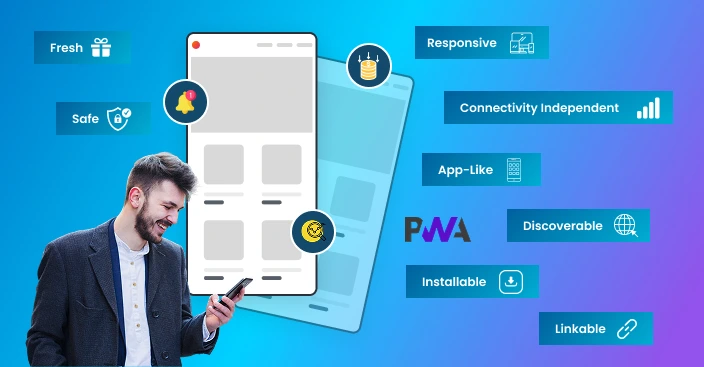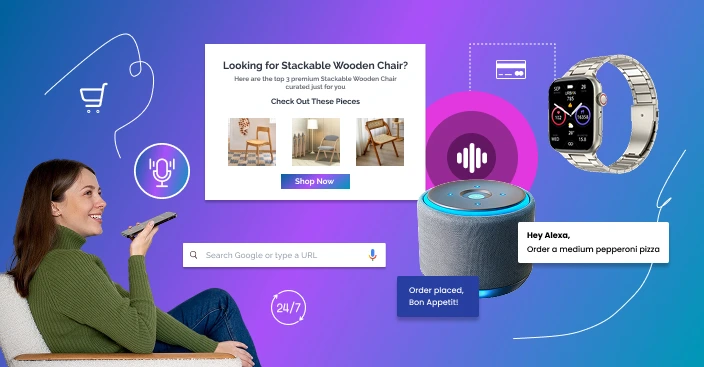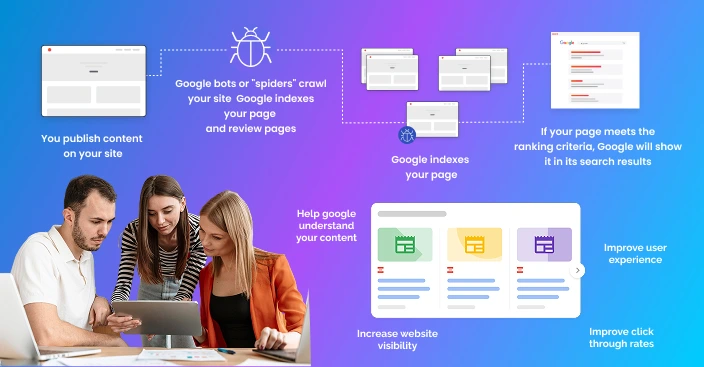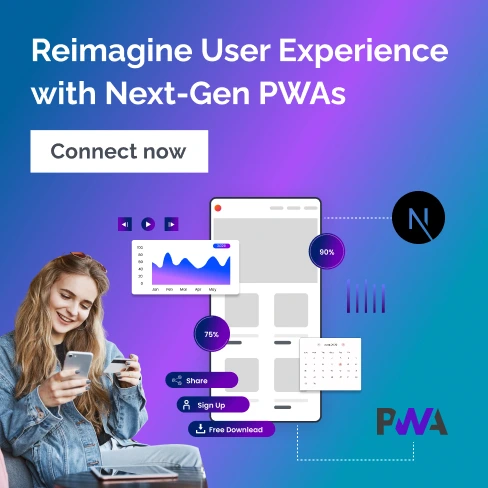The Future of Progressive Web Apps: Recent Trends in 2025

With the world fast becoming mobile-first and user-centric, the demand for quicker, smoother, and world-reachable applications has never been greater.
Here step into Progressive Web Apps (PWAs), which are making their mark permanently. A mix of the best of web and mobile experiences, PWAs have become a breakthrough technology that is rewriting the rules of how companies engage with users.
They are fast, reliable, and installable from a browser directly without taking up much storage on a device powerful solution for businesses that want native-app-like experiences without the friction.
In this article, we will explore the recent trends of progressive web apps for the UK market.
What Makes PWAs Must-Haves in 2025?
PWAs in 2025 will further evolve based on developments in artificial intelligence, interconnectivity with smart devices, and more profound personalisation abilities.
As customer aspirations increase, the future of PWAs is not only about performance but providing adaptive, intelligent, and hyper-personalised experiences that adapt to users’ real-time needs.
As opposed to traditional apps that anticipate the user downloading them from an app store, PWAs can be opened in a browser and installed on a device’s home screen.
They are very quick to launch even on low network connectivity, and they provide support for push notifications, offline capabilities, and background updates.
What makes them especially appealing in the current era is that they’re also search engine-indexed and sharable by URLs, which is in stark contrast to native apps that are walled in app stores.
Discover The Key Trends of Progressive Web Apps For UK
Artificial Intelligence Powers Personalisation
One of the most significant trends powering the future of PWAs is the use of artificial intelligence. AI will play a key role in enabling PWAs to personalize content and functionality based on user behavior, preference, location, and interaction history.
In eCommerce, for instance, this means a user seeing a personalised homepage with suggested products, the option of optimised delivery, and predictive search results based on their browsing history.
AI also enables chatbots, voice search, and smart automation, which enables the user experience to be fast-tracked and intuitive. As AI evolves, expect PWAs to deliver dynamic experiences that adapt in real time.
IoT Integration Extends PWA Capabilities
Another trend-shaping wave is the convergence of PWAs with Internet of Things (IoT) devices.
With an increase in devices that are interconnected at home, factories, and transportations, PWAs are emerging as the light-weight interface of choice to control and interact with them.
Be it controlling smart home devices to monitoring logistics and inventories within warehouses, PWAs offer a quick and cross-platform interface that can run on nearly every device with a browser.
Their ability to perform well on low-spec devices makes them ideal for industrial and remote deployments.
Voice Interfaces Redefine User Experience
Voice search and voice interfaces are also seeping into the realm of PWAs. With users now relying more on voice to interact with devices, especially mobile and wearable, the integration of voice functionality into PWAs becomes mandatory.
With advances in speech recognition and natural language processing, PWAs in 2025 will support voice queries, guide users through the application by verbal instructions, and even provide voice transactions.
This change not only enhances accessibility for the disabled but also responds to increasing demand for hands-free digital engagement.

Headless Architecture Drives Flexibility
One of the most strategic technological developments in PWA development is the use of headless architecture.
In doing this, the front end (user interface) is separated from the back end (data and logic) and connected via APIs.
PWAs built on headless architecture allow developers more leeway to create consistent experiences across multiple channels—mobile, desktop, kiosks, and wearables.
For businesses, this means faster time to market, easier updates, and the capacity to test different front-end designs without affecting backend systems. Headless commerce with PWAs in 2025 is going to dominate the eCommerce world with record-breaking performance and customizability.
Security Features Enhance User Confidence
Security is one of the most important areas of concern for PWA in the coming years. With exponentially growing online payments and user data, secure communication and data storage are top priorities.
PWAs have been running over HTTPS by default already, but new protocols and technologies will make them even more secure. Multi-factor authentication, token-based authorisation, and biometric integrations are gaining traction in PWA development.
These features are particularly important for industries like banking, healthcare, and eCommerce, where the security of information is of the utmost importance.
PWAs Enter the App Store Ecosystem
The biggest shift in the PWA world is their growing presence in app stores. PWAs once existed only through browsers, but today they can also be submitted to stores like the Google Play Store and Microsoft Store.
Even Apple, otherwise more stringent, is beginning to loosen its stance on PWA support. That enables businesses to deliver the findability value of native app stores with none of the inflexibility and inefficiency of PWAs.
In 2025, more businesses will employ this hybrid approach, using the app store as a distribution channel but serving their app as a PWA in the background.
Scalability Across Devices
PWAs are even extending to non-traditional platforms such as smart TVs, wearables, and even automotive infotainment systems.
As screen types and device types become more diverse, PWAs stand out because they can easily scale across multiple resolutions, screen sizes, and interaction modes.
For instance, the same PWA experience can be delivered by a media platform on a smartphone, tablet, and smart TV with minimal adjustments in the codebase.
This flexibility spares businesses from creating separate apps for every platform and hence maintains branding and functionality intact.
PWAs in Enterprise Workflows
In the enterprise, too, the use of cross-platform PWAs is increasingly in vogue. Companies are increasingly using PWAs to power internal applications, employee portals, and customer service interfaces. PWAs are easier to deploy, update, and maintain than traditional desktop apps across divisions and devices.
They are also ideal for field or remote workers who need access to data with or without internet connectivity.
In logistics, construction, and field services, PWAs keep employees connected and on the same page with real-time data synchronisation and offline capabilities.
No-Code and Low-Code PWA Builders
One of the most significant upcoming trends to watch for is the production of low-code and no-code platforms for creating PWAs.
Such platforms provide non-tech-savvy users, such as marketers, designers, and small business owners, the functionality to create operational PWAs with minimal coding.
Democratisation of development will fuel innovation, allowing more businesses to create and deploy apps faster through prototyping.
In 2025, anticipate small and medium-sized businesses rapidly adopting no-code solutions for building customer portals, booking systems, product catalogues, and so forth.
The future of PWAs is also closely tied to their performance in search engines. Unlike native apps, PWAs are fully indexable by Google, which means they contribute directly to a brand’s organic traffic.

Since Google continues to emphasise page experience and Core Web Vitals, PWAs—naturally—are checking a lot of those boxes. They are quick to load, adapt to any screen, and deliver smooth navigation, all of which boost engagement and reduce bounce rates.
For content-heavy websites such as news websites or educational platforms, PWAs offer an SEO-friendly way of delivering fast and engaging experiences.
Real-World PWA Success Stories
Lancôme UK
Lancôme introduced a PWA to enhance mobile shopping in the UK. With improved load times, offline accessibility, and effortless navigation, it provided a luxury experience even on low-speed connections.
They got a great outcome of 17% and more increase in iOS conversions and more than 50% more mobile sessions. Push notifications re-engaged users with offers and product news, providing better accessibility and responsiveness to UK mobile-first consumers.
Trivago
Trivago launched a PWA to simplify hotel searches and bookings for its UK users. The app provided instant load time, offline browsing, and price drop push notifications, without the need for app installation. Post-launch, Trivago experienced a 150% increase in user engagement.
The PWA enabled travellers on the move to find offers quickly and revisit searches, leading to improved session duration, increased user retention, and greater booking rates.
AliExpress UK
AliExpress built a PWA to serve mobile users reluctant to install its native app. In the UK market, the PWA provided faster browsing, fluid navigation, and push-based re-engagement, resulting in a 104% boost in conversions for new users.
Its lightweight nature and offline support made it perfect for slower networks or older devices, enabling the brand to increase reach and decrease cart abandonment.
Conclusion
Progressive Web Apps are now not a “nice-to-have” feature; they’re the future of digital experience. With the advancements in AI, headless architecture, IoT connectivity, and no-code abilities, PWAs are accelerating user journeys to be faster, smarter, and more scalable.
As consumer expectations is shifting, business-used platforms also need to shift. PWAs will be leading the charge for unified, intelligent, and accessible web experiences in 2025.
Connecting with a mobile app development experts can be helpful to implement progressive web apps effectively for your UK market.
FAQs
 Is a PWA better than a native app?
Is a PWA better than a native app?
PWAs have many advantages over native apps, including faster loading, offline support, lower development cost, and device support.
Native apps may still be needed for complex functionalities or where high device integration is needed. Otherwise, PWAs are usually a better and scalable option.
 Can PWAs help with SEO?
Can PWAs help with SEO?
Yes, PWAs are very SEO-friendly. While native apps are not indexable by search engines, can’t be crawled, and don’t contribute to your site’s organic visibility, PWAs can.
They also prefer features like fast loading and responsive design, which Google prefers to reward in search rankings.
 Do PWAs work offline?
Do PWAs work offline?
PWAs are designed to operate offline or with low connectivity through the assistance of service workers holding data.
This enables the users to continue browsing or interacting with the app even without internet availability.
 What type of businesses should embrace PWAs?
What type of businesses should embrace PWAs?
PWAs are ideal for eCommerce, media sites, schools, booking sites, logistics companies, and any business looking to provide smooth digital experiences with the expenses of natively developed apps.
 Why Magneto IT Solutions is Ideal for PWA development?
Why Magneto IT Solutions is Ideal for PWA development?
Magneto IT Solutions is a global leader in PWA development with over 14 years of experience and 250+ successful projects across industries.
Our skilled professionals have the capability to develop high-performing, SEO-friendly PWAs that are secure, scalable, and user-friendly.
Be it custom mobile app development or headless PWA, or eCommerce integration, we offer full-cycle development and 24/7 support to bring your idea to life.




